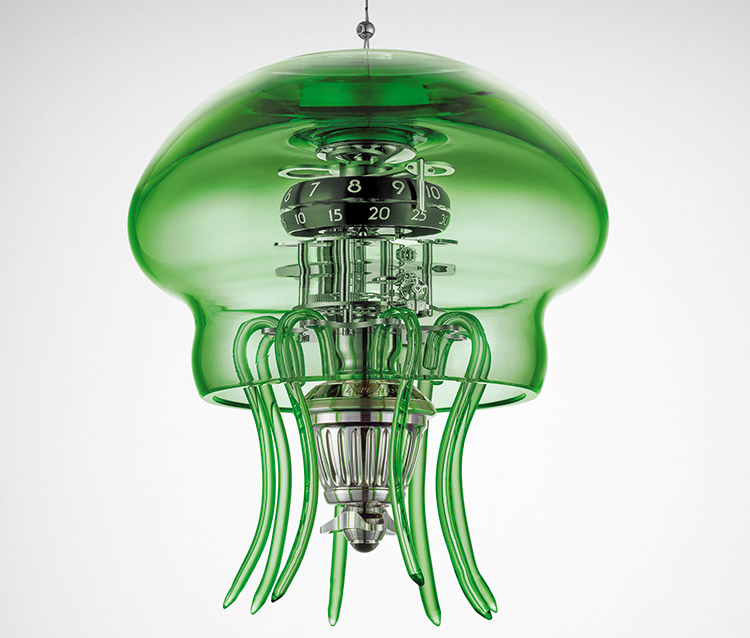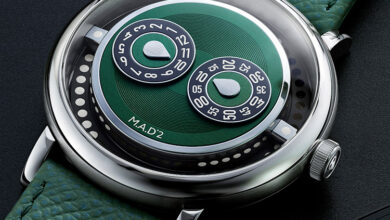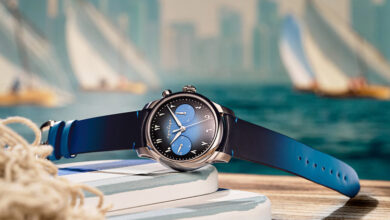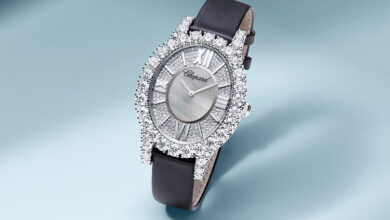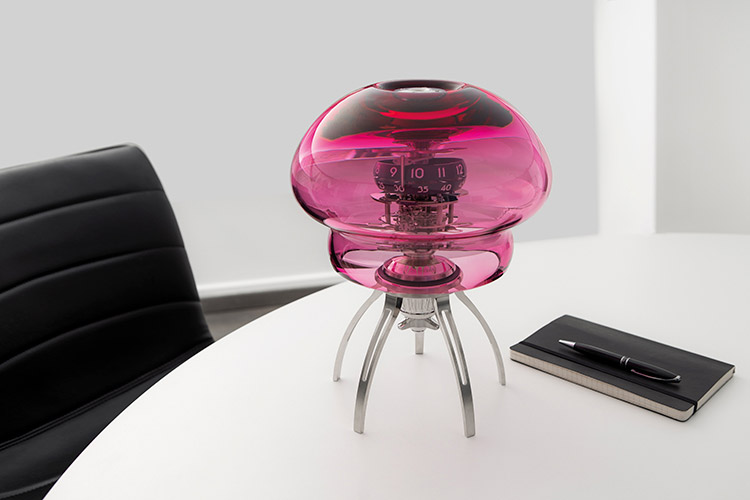
In its tenth collaboration with Switzerland’s premier clockmaker, L’Epée 1839, MB&F plunges into warm ocean waters where the beautiful and ancient jellyfish proliferate. Medusa is a dual-configuration clock, housed in hand-blown Murano glass, that can be ceiling mounted or stood upon a desk. In the form of one of the most compelling yet mysterious creatures of the sea, Medusa blends exceptional artisanal skill with Swiss horological precision, and introduces new frontiers in both
The central mass of Medusa is formed by a large transparent dome of hand-blown Murano glass that evokes the bell-shaped body of a mature jellyfish. Two rotating rings, one displaying the hours and the other displaying the minutes, are visible through the dome, and the time is read off a single fixed indicator that extends over the rings. Like a jellyfish glowing in the abyss, Medusa glows in the dark thanks to Super-LumiNova. A 2.5Hz (18,000vph) movement beats underneath the time indication, forming the pulsating heart of this mechanical creature.
The movement of Medusa is entirely new and required over two years of development by L’Epée 1839. L’Epée went back to the drawing board for Medusa, designing the movement entirely from scratch. Due to the weight of the outer glass shell and its vulnerability to shock damage, it was necessary to build a movement that could be wound one-handed, with the other hand available to stabilise the clock. Additionally, with most of the movement surrounded by glass, access to any winding or setting mechanisms would be limited.
In a departure from their previous clock movements, L’Epée 1839 combined the winding and setting systems in the Medusa movement. A single propeller element, which projects from the bottom of the movement for easy access, is rotated anticlockwise to wind the movement and clockwise to set the time.
Medusa can be set on a desk or any flat surface thanks to a special steel frame with curved legs, designed to receive the base of the movement while allowing for easy access to the winding and setting mechanism. When hung from the ceiling, Medusa can be further decorated with its hand-blown Murano glass tentacles, which hook onto the movement and sway gently with the slightest motion of the clock – recalling a free-floating jellyfish carried along by the current.
With no reinforcing outer support structures, the movement of Medusa has been deliberately built to resemble the internal neural network of a jellyfish, with a central column and radial elements. This feature is not simply aesthetic; in terms of engineering it helps to preserve the integrity of the clock as it is suspended from the ceiling.
Perfecting the glass exterior of Medusa – available in blue, green or pink – was as challenging as any aspect of its movement creation. The pink edition, in particular, required multiple stages of layering red and clear glasses to achieve exactly the right shade desired.
For the best possible aesthetic result, the dome and tentacles had to be crafted from the same glass, to give them the same optical qualities. The skill needed to produce by hand a set of consistent glass tentacles for each clock exists only in very few glassblowing houses. Add to this the difficulty of creating a hand-blown Murano glass dome that has to appear extremely light and delicate, and yet withstand the weight of a clock movement – it’s easy to see why only one Murano glassblower, out of the 40 companies that L’Epée 1839 approached, was able to accomplish the task.
Independent designer Fabrice Gonet first proposed Medusa in 2016 to MB&F founder, Maximilian Büsser, who immediately saw the appeal of Gonet’s sketch and recognised the essential spirit of an MB&F creation in its lines.
The associations that come with the name Medusa are varied and span the entire range of human experience, from the natural world’s mesmerising jellyfish with its trailing tentacles to the Gorgon of Greek myth whose every appearance could turn a man to stone. One thing is for sure, once you gaze into the depths of Medusa, it is hard to look away.
Medusa comes in three limited editions of 50 pieces, each in a different colour – blue, green and pink – chosen to reflect the natural hues of a jellyfish.

